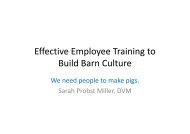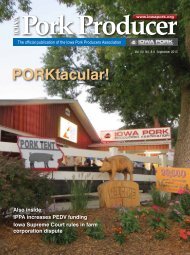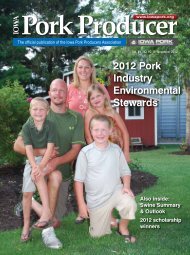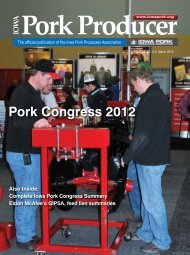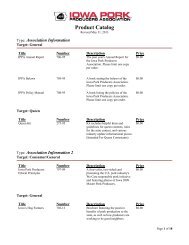September 2011 - Iowa Pork Producers Association
September 2011 - Iowa Pork Producers Association
September 2011 - Iowa Pork Producers Association
You also want an ePaper? Increase the reach of your titles
YUMPU automatically turns print PDFs into web optimized ePapers that Google loves.
Floor space and journey time research<br />
increases profits for swine producers<br />
By Jennifer Shike, University of Illinois<br />
Recent University of Illinois research<br />
confirms that the swine industry has<br />
come a long way in the past 10 years<br />
to improve pig transportation and<br />
handling. In this study led by graduate<br />
student Chad Pilcher, researchers<br />
discovered that an optimum allocation<br />
of floor space per pig during transport<br />
and a longer journey time allow pigs to<br />
better handle transportation stress.<br />
Mike Ellis, U of I professor of animal<br />
sciences, said their research started<br />
10 years ago when it became<br />
apparent that losses of pigs during<br />
the transportation process had<br />
increased since the early 1990s.<br />
This caused great concern in the<br />
swine industry from both an<br />
animal welfare and economic<br />
perspective.<br />
“Our goal was to understand<br />
why those losses were occurring<br />
and develop approaches to<br />
minimize them,” Ellis said.<br />
“Significant funding from the<br />
National <strong>Pork</strong> Board and several<br />
commercial companies, including<br />
ELANCO Animal Health and<br />
The Maschhoffs, allowed us to<br />
perform research in a controlled,<br />
commercial setting. It’s a great<br />
example of how the industry<br />
came together to attack a problem<br />
and make positive change.”<br />
One of the challenges of this type<br />
of research is controlling the<br />
factors such as animal handling<br />
that contribute to losses, he said.<br />
By working with commercial<br />
producers to perform on-farm<br />
research, Ellis’s team was better<br />
able to control who worked<br />
with the pigs and how they were<br />
handled while remaining in<br />
typical commercial conditions.<br />
“We were able to perform<br />
controlled research where the<br />
pigs were handled the same so<br />
we could evaluate journey time<br />
and floor space,” Ellis said. “We<br />
discovered that the lower the<br />
floor space available per pig,<br />
the higher the losses can be.<br />
However, there is evidence that<br />
you can give them too much floor<br />
space. When pigs are transported,<br />
they are more likely to be thrown<br />
about if there is too much open<br />
space. If they are closer, but not<br />
too close, they can help support<br />
each other.”<br />
20 SEPTEMBER <strong>2011</strong>




